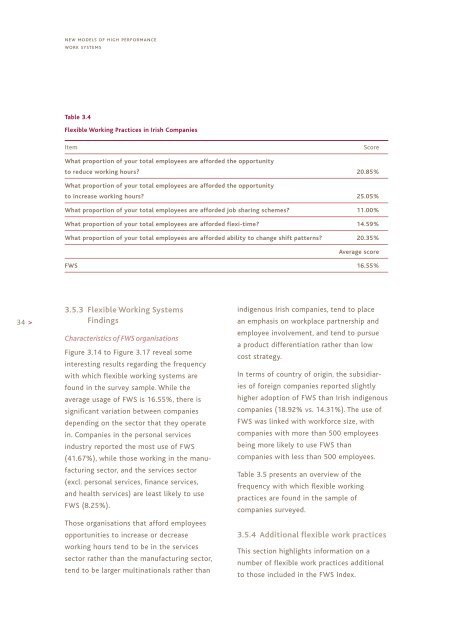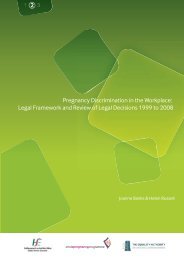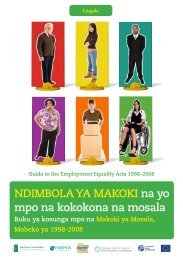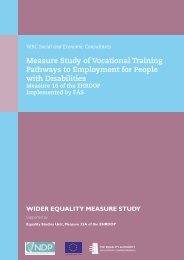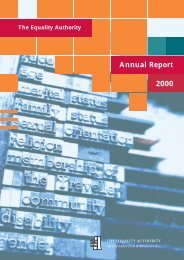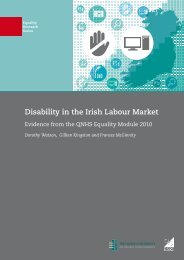New Models of High Performance Work Systems - Equality Authority
New Models of High Performance Work Systems - Equality Authority
New Models of High Performance Work Systems - Equality Authority
- No tags were found...
You also want an ePaper? Increase the reach of your titles
YUMPU automatically turns print PDFs into web optimized ePapers that Google loves.
new models <strong>of</strong> high performancework systemsTable 3.4Flexible <strong>Work</strong>ing Practices in Irish CompaniesItemScoreWhat proportion <strong>of</strong> your total employees are afforded the opportunityto reduce working hours? 20.85%What proportion <strong>of</strong> your total employees are afforded the opportunityto increase working hours? 25.05%What proportion <strong>of</strong> your total employees are afforded job sharing schemes? 11.00%What proportion <strong>of</strong> your total employees are afforded flexi-time? 14.59%What proportion <strong>of</strong> your total employees are afforded ability to change shift patterns? 20.35%Average scoreFWS 16.55%34 >3.5.3 Flexible <strong>Work</strong>ing <strong>Systems</strong>FindingsCharacteristics <strong>of</strong> FWS organisationsFigure 3.14 to Figure 3.17 reveal someinteresting results regarding the frequencywith which flexible working systems arefound in the survey sample. While theaverage usage <strong>of</strong> FWS is 16.55%, there issignificant variation between companiesdepending on the sector that they operatein. Companies in the personal servicesindustry reported the most use <strong>of</strong> FWS(41.67%), while those working in the manufacturingsector, and the services sector(excl. personal services, finance services,and health services) are least likely to useFWS (8.25%).Those organisations that afford employeesopportunities to increase or decreaseworking hours tend to be in the servicessector rather than the manufacturing sector,tend to be larger multinationals rather thanindigenous Irish companies, tend to placean emphasis on workplace partnership andemployee involvement, and tend to pursuea product differentiation rather than lowcost strategy.In terms <strong>of</strong> country <strong>of</strong> origin, the subsidiaries<strong>of</strong> foreign companies reported slightlyhigher adoption <strong>of</strong> FWS than Irish indigenouscompanies (18.92% vs. 14.31%). The use <strong>of</strong>FWS was linked with workforce size, withcompanies with more than 500 employeesbeing more likely to use FWS thancompanies with less than 500 employees.Table 3.5 presents an overview <strong>of</strong> thefrequency with which flexible workingpractices are found in the sample <strong>of</strong>companies surveyed.3.5.4 Additional flexible work practicesThis section highlights information on anumber <strong>of</strong> flexible work practices additionalto those included in the FWS Index.


